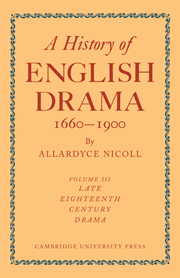Chapter Four - MISCELLANEOUS FORMS OF DRAMA
Published online by Cambridge University Press: 05 March 2012
Summary
Definitions
In the discussion of the conflict between sentimentalism and what we might style the older traditions we must not lose sight of the fact that we must take into account many other forms besides the regular comedy and the already long-established farce. Already in the early eighteenth century new forms of dramatic literature, such as the ballad-opera and the pantomime, were springing into birth, and this tendency towards the development of fresh species continued in the years after 1750. Pantomime continued on its triumphal career, now taking the form of pantomimic opera as it had done in the time of Lewis Theobald, now moving towards the region of the pure “entertainment” – little more than a spectacular harlequinade. So, too, burlesques, pastorals, “dramatic poems” and similar pieces helped to fill out the body of dramatic workmanship in the age.
Of all these miscellaneous forms unquestionably the most popular were the comic opera, the operatic farce, the burletta and the “interlude”; it is concerning the significance of each of these terms that something must be said in this section. In the previous volume of this history of English drama it was noted that the ballad-opera, as created in 1728 by John Gay, ran its course within a few years and suddenly disappeared.
- Type
- Chapter
- Information
- A History of English Drama 1660-1900 , pp. 191 - 228Publisher: Cambridge University PressPrint publication year: 1952



